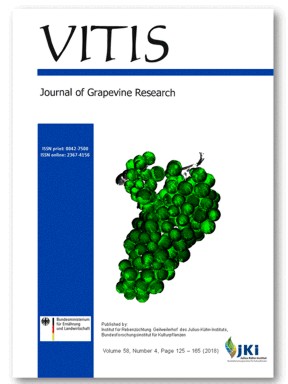Evaluation of photosensitive films for light measurements in the fruiting zone of grapevine canopies
DOI:
https://doi.org/10.5073/vitis.2018.57.159-165Keywords:
light interception; microclimate; solar radiation; training system; light sensitive dyes.Abstract
The potential influence of fruit exposure and canopy manipulations on grape berry composition is well recognized. However, a simple and low cost method for quantifying the amount of light reaching the fruiting zone is lacking. The objective of the present study was to test the application of a commercial system of photosensitive azo-dye coated plastic films for characterizing light conditions within grapevine canopies. The fading rates of three films of differing light sensitivity were initially monitored in a fully exposed position, and these all showed a linear or near linear relationship with radiation measured by an adjacent global solar radiation sensor. When mounted in the fruiting zone of a vertically trained cool climate 'Riesling' vineyard for two periods following early and late leaf removal treatments, the films were able to quantify the change in light exposure within the fruiting zone. Total radiation values calculated using an on-site calibration or manufacturer´s equation were comparable. While some consideration is needed with regard to the choice of film sensitivity and positioning within the canopy, these initial evaluations suggest these light sensitive films can provide a simple and accurate method for characterizing light conditions and quantifying cumulative radiation within the fruiting zone.
Downloads
Published
Issue
Section
License
The content of VITIS is published under a Creative Commons Attribution 4.0 license. Any user is free to share and adapt (remix, transform, build upon) the content as long as the original publication is attributed (authors, title, year, journal, issue, pages) and any changes to the original are clearly labeled. We do not prohibit or charge a fee for reuse of published content. The use of general descriptive names, trade names, trademarks, and so forth in any publication herein, even if not specifically indicated, does not imply that these names are not protected by the relevant laws and regulations. The submitting author agrees to these terms on behalf of all co-authors when submitting a manuscript. Please be aware that this license cannot be revoked. All authors retain the copyright on their work and are able to enter into separate, additional contractual arrangements.



